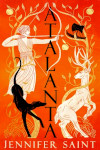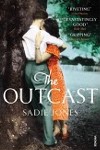Merryn Allingham – The Crystal Cage
Posted 15th October 2014
Category: Reviews Genres: 2010s, Angst, Domestic, Historical, Mystery, Paranormal, Social, Spiritual
1 Comment

Time may change, but there will always be that person in a similar situation.
Publisher: Harlequin
Pages: 234
Type: Fiction
Age: Adult
ISBN: 978-1-460-33836-0
First Published: 1st August 2014
Date Reviewed: 14th October 2014
Rating: 3.5/5
Nick won’t give up, so Grace agrees – an otherwise usual day as a property historian/gallery assistant is changed when Grace accepts the energetic Nick’s proposal that they work together on his commission to discover whether a Victorian architect designed for the Great Exhibition. Grace’s life is ruled by her partner (bed and work) Oliver, and she’s done a good job of pretending she’s happy for nine years, but Nick’s offer, whilst overwhelming, piques her interest. Little is known of Lucas Royde’s career before he became famous, but that might just be about to change.
The Crystal Cage is a dual-plot novel that studies the art world and history but later takes a long look at the expectations people have of each other, especially those less well-off (in all ways), than themselves, to good effect.
None of the characters are likeable, however whether or not they are supposed to be is not obviously stated and so it would be fair to say that if you go into the book knowing that this is the case, you are likely to finish it more content than someone who goes in expecting happiness and romance. Be not ye fooled by the name of the publisher, there is little real romance here and, given the subjects, it is all the better for it.
Lucas, for example, is assuming and takes jealousy to an extreme level. A subtle, non-violent level, but one all the same. The man who is quite obviously in lust rather than love hates his rival from the word ‘go’ with scant reason and it can be hard to feel anything for him when he puts himself in such an awkward and socially unexceptionable position with little behind it that the reader can understand. His ‘romance’ is an interesting one, however, in part because of the way the author does not include any details from the point of view of the woman. Indeed the book would have been too long if she had been given a voice and so it may simply be that she was left out for no literary reason, so to speak, but nevertheless the effect is intriguing. You don’t hear a word from Alessia except through Lucas and therefore it is easy to believe that perhaps she is less in love with him than Lucas thinks, she is certainly more desperate and less powerful than Lucas can comprehend. Their story may be sad, and it may be true as much as the fiction can be, but what is left out ensures that there is a further link in the main social theme.
This theme is of control, the expectations I have stated above. Grace became Oliver’s partner in every sense of the word, but it was/is a case of what Oliver says, goes. He was the lifeline she needed – the security, the job, perhaps even the man in a sexual sense – as long as she was at his beck and call. It is somewhat a spoiler to say this, so you may want to move on to the next paragraph if you’d rather not know too much, but the theme continues somewhat with Nick. Bounding, get-up-and-go Nick, whom Grace likens to Tigger. Whereas Oliver’s persona may have been obvious from the start, at least it would have been if Grace had been less in need, Nick allows the author to show how control can come in different forms. Similarly Alessia is controlled by her reported love for Lucas, and by her husband. It’s interesting to compare the two situations because the contemporary version may hit harder, being closer to home than the Victorian period. But of course both are equally damning.
This all sounds very good, and it is, but this theme consumes the end rather than the main section of the book. The book is overwritten. It’s wordy, flowery, and rather repetitive, with ideas being repeated mere pages after they have already been stated. There is also an element of prolonged angst to it that can be difficult to read. The insistence by Lucas that he’s in love when the reader can see that it is pure lust makes the story difficult to continue.
Nick and Grace are rude. They literally run away from people who had made time for them as soon as they, Nick and Grace, realise the person doesn’t have much information for them. They are well-matched in their lack of tact and in their attitudes to others. Lucas is jealous, as said, hateful of too many, and assumes too much.
The mystery has many, many dead ends, and these are convenient, a way to keep the story going. After a couple of these occasions wherein a search looks promising but is then fruitless, it becomes too predictable and the meetings and searches boring. Then, later, this turns 180 degrees when ideas about Royde appear out of the blue with no ‘evidence’ (for Royde is fictional) behind them. Grace makes guesses that are correct, but they are too much of an assumption without the information the reader has been privy to.
Lastly there are a few names and places that invite confusion, and areas that, other than the filler content, could have used more editing.
Yet the history itself is appealing and there is enough factual information for the interested reader to jump from it into their own research. And the ending itself is highly appropriate and rather excellent. Allingham shows all the worries and backtracking of someone in a difficult situation but writes the ending that you could say is expected. She doesn’t make sweeping changes or include roses on doorsteps – she gives you the realistic truth and has her character remain strong. And she shows that backwards can often be a step forward.
Granted the history works best for the themes of control and independence and less so for the romance. It could be argued that the book would have been better without the Victorian romance, and certainly Grace’s story of discovery is more compelling, but the theme itself makes it all worth it in the end.
The Crystal Cage as a title is exactly what it seems to be, just as relationships often are not. It takes time and yes, effort, to get there, but the book is recommended.
I received this book for review from Historical Fiction Virtual Book Tours.
Related Books
None yet
M J Rose – The Collector Of Dying Breaths
Posted 14th March 2014
Category: Reviews Genres: 2010s, Domestic, Historical, Mystery, Paranormal, Romance
2 Comments
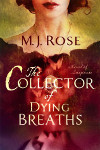
In hopes that the last breath isn’t the last at all…
Publisher: Simon & Schuster
Pages: 307
Type: Fiction
Age: Adult
ISBN: 978-1-451-62153-2
First Published: 8th April 2014
Date Reviewed: 14th March 2014
Rating: 3.5/5
In 1500s France, an apothecary’s apprentice is saved by Catherine de Medici and becomes one of her favourites, providing her with perfumes, potions, and poisons. He is happy in his position but his ultimate goal is to put into practise the theories of his old friend who believed life could be reborn. In present-day France, Jac looks at continuing the work of her brother Robbie, who died of a mysterious illness. History and modernity come together and Jac knows she is taking on the past. She also knows about her brother’s belief that her hallucinations are windows into days long gone, but she doesn’t know just how far it goes.
The Collector Of Dying Breaths is a dual-story book that uses history to good effect but to mixed results.
The story is predictable but it in a way that doesn’t spoil it too much – there is nothing that suggests the answers shouldn’t have been easy to guess. What may prove difficult, however, is the notion of dying breaths that the book rests on. Superstitions and theories about magic and the unknown where rife in the 1500s, but it can be hard to believe that anyone nowadays would consider the possibility that a breath captured in a bottle could recreate life. Whilst the theory is of course fine as a fantasy element, there is not enough of the genre overall to aid in the suspension of what is realistic required by the reader and so the resolution of the story may not be as compelling as it is supposed to be.
This is also true of the way the two time periods are woven together. Because Jac’s ‘ability’ is known from the start, the conclusion of this theme may not seem as interesting. However the biggest issue with the way the periods connect is one of belief, similar to that of the experiments. The past lives idea works by itself, but the way it is dealt with by the characters is overdone – and this is because the main character switches back and forth between being strong and weak, knowledgeable and naïve in odd ways, that make the answers unsatisfying.
Part of the issue has to do with the writing style. There is a lot of telling involved, in fact Jac remains undeveloped for a fair amount of time. Information about her is suddenly included as though you’ve walked in during the middle of a conversation, and facts are dropped randomly that it’s hard not to feel should’ve been stated within the first few pages. Where there is a lot of unnecessary information about historical people and perfumes (more than is needed for this story of perfumers) the book could do with more information on Jac, shown. Nationalities are also difficult to discern and the historical language, whilst generally good, does veer towards the 21st century on occasion.
The history itself is believable and well written. Catherine de Medici is portrayed in a somewhat bad light that might be worse than reality but is far from awful, and you can see where the author has filled gaps in history and used certain factors as a springboard into fiction. The author has no qualms about showing the dark side of court and how quickly an enemy or simply a person of higher standing would be quietly removed.
There are sex scenes in both eras, fairly graphic and in the case of the 1500s showing the religious hypocrisy apparent. One of the contemporary scenes provides a moment of contemplation for the character that seems to be a way for the author to explore a trend and is a little out of place overall, but otherwise, especially where the historical chapters are concerned, the scenes work.
Due to the predictability and sudden switches in thoughts early on, it is hard to get a handle on the story and difficult to say you really know the characters and care about them – the story can be confusing. That said, the history is interesting and accurate enough, and the mystical aspects appealing if not used to full effect.
The Collector Of Dying Breaths is unlikely to make your best of list, but it isn’t bad and the history is informative.
I received this book for review from for Historical Fiction Virtual Book Tours.
Related Books
None yet
Melissa Marr and Tim Pratt (ed.) – Rags & Bones
Posted 28th October 2013
Category: Reviews Genres: 2010s, Fantasy, Horror, Paranormal, Science Fiction, Short Story Collections
6 Comments
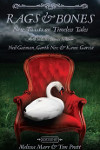
Building from the foundations.
Publisher: Headline (Hachette)
Pages: 365
Type: Fiction
Age: Adult
ISBN: 978-1-4722-1052-4
First Published: 22nd October 2013
Date Reviewed: 25th October 2013
Rating: 5/5
A baker’s dozen of creators, including Marr, Pratt, and one artist, have teamed together to produce a collection of short stories based on others’ works.
Rags & Bones is an anthology that retells several stories – all with some sort of fantasy, paranormal, and/or horror base – to create one solid and undeniably excellent book.
It’s interesting to note that the title of the collection comes from its concept. Marr and Pratt wished for stories that were the result of existing tales rewritten it to the effect that the meaning was still there, and perhaps certain elements (for example Neil Gaiman’s The Sleeper’s Spindle is very much Sleeping Beauty) – but were still original works. As the editors put it: “boil those stories down to the rags and bones, and make something new from their fundamental essences”.
And it works. Whilst the stories may indeed at times be easy to place within their context, at others it is more difficult. Certainly it is to the collective’s advantage that the stories chosen for reworking are not all timeless classics. There are lesser known works amongst them which means that there is a lot of ‘new’ for the reader, as well as ‘old’ – it is unlikely that any one reader will know of every story represented.
The stories themselves are compelling and the writers chosen are all rather famous. The horror in the tales is often understated and of the grim, psychological sort rather than the gore and violence sort. And the range of settings and times is vast. Sometimes it is difficult to ascertain when or where a story is set. This adds to the tales rather than detracts.
So each story bares a message. Carrie Ryan’s brilliant That The Machine May Progress Eternally takes on E M Forster and weaves a foreboding tale of a child of a post-apocalyptic earth falling into the technological underworld where humans with no reason to move about study history from the safety of their kingdom. Neil Gaiman’s The Sleeping Spindle borrows from Hans Christian Anderson and switches elements around to create a humorous version of an already chilling children’s story. Melissa Marr herself channels Kate Chopin and writes of selkies, a mer-woman imprisoned by a well-meaning but abusive human, in a study of both the selkie myth itself and the wider context of inequality. And then there is the exceptional When First We Were Gods by Rick Yancey, the longest story in the book, a purely sci-fi retelling of The Birth-Mark by Nathaniel Hawthorne that focuses on a specific sort of human immortality, looking at what is lost when forever is achieved. Woven into the collection are Charles Vess’s illustrations, artistic retellings of older tales and poems. The addition of Vess’s work is a reprieve of sorts, a nice method of segmentation, that is provided just as much time for explanation as the written works. (Each contributor explains their inspiration and why they chose it following their story.)
The works highlighted above are those chosen by the reviewer – there are plenty more and each one is just as worthy as the rest. There are no average stories in the collection, the sensational quality is consistent throughout. And whilst the messages and meanings may differ from one to the next, the overall ideas of knowledge, of thinking before you act, of human agency in general.
On the face of it, Rags & Bones is a mixture of oft-scary genres, but it is so much more. Real horror comes in patches, slowly, and timeless fantasies tend to have a dark base. You don’t read this book, become frightened and miss a night’s sleep. You will sleep at night. What these stories do is creep into your consciousness and make you aware of very real ideas and possibilities, as well as things that already happen. And this is regardless of whether the story is of a believable future or of vampires and zombies.
The gorgeous cover art will stay with you, the collective of popular and talented talented writers will stay with you, and the concept of wishes coming with a price, like Rumplestiltskin’s promise, will stay with you and haunt you for a good while.
There are ways to scare, there are ways to inform, and then there is Rags & Bones.
I received this book for review from Headline.
Related Books
Kimberly Derting – Dead Silence
Posted 12th July 2013
Category: Reviews Genres: 2010s, Paranormal, Romance, Thriller
1 Comment
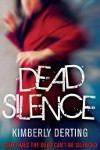
It’s been closer to home, now it’s at home.
Publisher: Headline (Hachette)
Pages: 389
Type: Fiction
Age: Young Adult
ISBN: 978-0-7553-8917-9
First Published: 16th April 2013
Date Reviewed: 9th May 2013
Rating: 4.5/5
Violet has recovered from her ordeal and still has the echo to prove it. But it won’t be long before she’s back to using her abilities. There’s to be two additions at school, making life complicated, and Violet never has been able to listen when people tell her to phone for help rather than investigate a crime scene herself.
Dead Silence is the fourth book in The Body Finder series. Derting is as good as ever, Violet is as strong as ever, the romance includes all those details and questioning you wish other YA books would include, and the series has got ever more unapologetic and mature as Violet gets older. As always Derting never shies from the gruesome truth, and in fact Dead Silence has some gruesome information about related subjects, too.
This time the story is more involved with the characters directly. Not that the series was ever lacking in either character development or plot (indeed Derting balances character and plot-driven nicely) but this time there is a little more focus on Violet and her friends for good reason – the setting doesn’t move so much between her ‘factions’ and there is reason to concentrate on her home and school life whereas before the concentration needed to be on the cases. And this, even though the crimes are just as thought-out and included. There is also a lot more back story as to the history of abilities, as well as insights into the mysterious Dr Lee.
Derting has focused on crimes that are fuelled by motives that have become very ‘every day’. She does provide lessons and suggestions for her readers but she also looks at the other side (in other words the book does not preach because of the basic structure of the books – the switch between Violet and the killer). Again ‘balance’ is the word of the day – the crimes are bad, like the other books, but there is a particular humanity in Derting’s portrayal of the killer’s life that demonstrates how upbringing has a lot to answer for. It does not excuse the crime, but puts it in terms that fit Violet’s life – gruesome, but not so far away that Violet, nor Derting, nor the reader, could put it in a box and move on. It might be a closed case now, because Derting doesn’t continue a crime beyond one book, but the way Derting has approached it means that it is poignant nonetheless, and perhaps the ultimate in showing rather than telling.
Violet makes a choice in this book to tell another person of her abilities. Her choice may not please everyone due to the way the person reacts, but it does bring a new element into the story, keeping it fresh, and one assumes Derting knows how this choice might affect her books as she uses it to a particular end.
The only thing that holds the book back is the writing; it’s not bad but it lacks Derting’s previous continuous strength, and there are some grammatical errors that aren’t the sort you would expect editors to pick up – they are style errors. There are also a couple of occasions where Derting is either too contemporary (regarding the way the back story is presented) or uses particular slang as her writer’s voice. These are generally ‘niggles’ but collectively they do faze the book.
Nevertheless, Dead Silence is a must-read. It could possibly be read as a stand-alone but it would be difficult for the reader to fully appreciate what Derting has created. For the faithful follower, it may just be the best yet.
I received this book for review from Headline.
Related Books
Sadie Jones – The Uninvited Guests
Posted 27th May 2013
Category: Reviews Genres: 2010s, Comedy, Domestic, Historical, Paranormal, Social
7 Comments

Sense And Sensibility And Sea Monsters and… you know the deal.
Publisher: Vintage (Random House)
Pages: 354
Type: Fiction
Age: Adult
ISBN: 978-0-099-56369-3
First Published: 1st January 2012
Date Reviewed: 21st April 2013
Rating: 5/5
It’s Emerald’s birthday, and as her step-father leaves to go to a meeting to discuss the family’s ability to keep their house, everyone is getting ready for the dinner party. Charlotte is in a whirl and not sure about her daughter’s friends, Clovis is being his usual self, and Smudge is unwell and thinking about the charcoal drawings on her wall. But an unexpected call from the railway changes everything, as the family find themselves having to make allowances for a crowd of people left waiting after a train accident. It’s a weird group of people, and it gets stranger still when an old acquaintance of Charlotte’s arrives as another passenger of the train.
The Uninvited Guests is a peculiar book that turns the notion of literary fiction on its head. Not at all what you’d expect from Jones, the book is somewhat of a parody, yet retains its literary feel throughout.
Jones’s writing is as good as it has been since her début. History is still the period of the day, The Uninvited Guests appearing to take place around the early twentieth century, but there is also a great amount of humour in the book. Either Jones has taken a chance or she wishes to show that literary fiction need not be so separate from genre fiction.
The action takes place over the course of 24 hours, with the majority of the book contained to the evening. A lot happens; it can be hard to remember it is still the same day. What fills the book and keeps it from ever being dull is the number of characters and their development. Apart from the ‘guests’, who are generally observed as a whole group rather than given time individually, the characters are all related in some way and each is distinctive – as detailed to some degree by the summary above. They all have their own stories and goals within the main one assigned to them as a unit, and this means that Jones switches back and forth between them when they’re separated. Jones’s usage of solo plots works here because of the nature of the characters, for example Charlotte is quite the snob and a bit lazy so she stays in her room, and Smudge is the oft-forgotten child and therefore spends a lot of time alone.
Owing to the period and the idea of the sudden burden of people, an aspect of the book lies in the family’s principles. The social status of the passengers compared to the family, the aims and aspirations of Charlotte, the wishes for a good birthday, and the general feeling of unwelcome arrivals, forms the basis of the book and is a big part of why it takes so long for the characters to work out what the reader knew all along (because in this book the reader is purposefully ahead of the game). It is a big part of the hilarity, too, and, somewhat uncomfortably, also the way Jones demonstrates neglect – for example the family literally forget little Smudge, which is what leads to her mishaps.
The dialogue is understandably steeped in its time and the writing is as good as Jones’s previous novels. The humour is both pure comedy and a sort of silliness. Sometimes Jones goes too far – as the book reaches its conclusion it could be said that the humour becomes a sort of private joke, rather over the top and unnecessary – and so it may shock readers who were thinking it might be more serious (despite the quotations and descriptions the book’s cover does not aptly indicate the nature of the contents). Thankfully the silliness resolves itself in the end – as much as possible given the plot.
Perhaps the best way to describe the book is to say that the characters would really like this to be character-driven, but Jones has decided that it is plot-driven. Indeed there is a constant push by the characters to forget the crowd of passengers and enjoy their evening.
There are lessons for the characters, and there is such development of them as to make you feel sorry to close the book, but really this story has no specific purpose. The Uninvited Guests is a novel that exists just because – it’s a laugh a minute but of no lasting value as literature. However that seems to be the point. As long as you’re okay with the idea of literary fiction being gatecrashed by paranormal dystopian stories – which is itself another possibility for the feelings of these ‘poor’ literary characters – and you’re willing to switch the angst-ridden beauty of Jones for frivolity, then you will likely love this book.
Jones’s latest – jolly good fun old chap.











